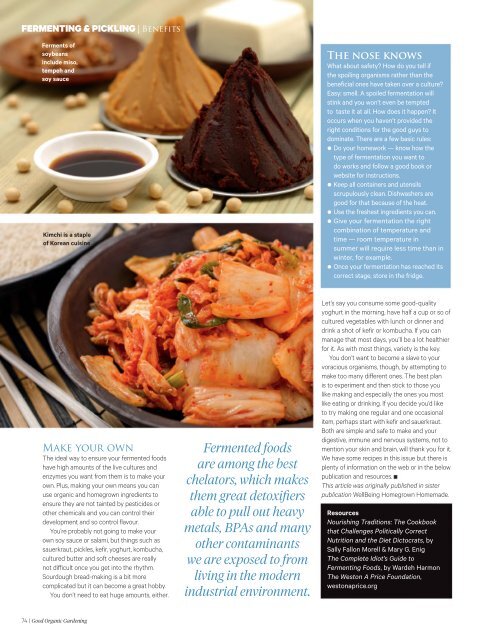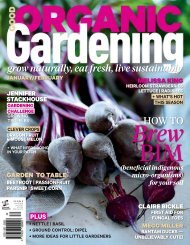3. Good Organic Gardening - May-June 2016 AvxHome.in
3. Good Organic Gardening - May-June 2016 AvxHome.in
3. Good Organic Gardening - May-June 2016 AvxHome.in
Create successful ePaper yourself
Turn your PDF publications into a flip-book with our unique Google optimized e-Paper software.
FERMENTING & PICKLING | Benefits<br />
Ferments of<br />
soybeans<br />
<strong>in</strong>clude miso,<br />
tempeh and<br />
soy sauce<br />
Kimchi is a staple<br />
of Korean cuis<strong>in</strong>e<br />
The nose knows<br />
What about safety? How do you tell if<br />
the spoil<strong>in</strong>g organisms rather than the<br />
beneficial ones have taken over a culture?<br />
Easy: smell. A spoiled fermentation will<br />
st<strong>in</strong>k and you won’t even be tempted<br />
to taste it at all. How does it happen? It<br />
occurs when you haven’t provided the<br />
right conditions for the good guys to<br />
dom<strong>in</strong>ate. There are a few basic rules:<br />
Do your homework — know how the<br />
type of fermentation you want to<br />
do works and follow a good book or<br />
website for <strong>in</strong>structions.<br />
Keep all conta<strong>in</strong>ers and utensils<br />
scrupulously clean. Dishwashers are<br />
good for that because of the heat.<br />
Use the freshest <strong>in</strong>gredients you can.<br />
Give your fermentation the right<br />
comb<strong>in</strong>ation of temperature and<br />
time — room temperature <strong>in</strong><br />
summer will require less time than <strong>in</strong><br />
w<strong>in</strong>ter, for example.<br />
Once your fermentation has reached its<br />
correct stage, store <strong>in</strong> the fridge.<br />
Make your own<br />
The ideal way to ensure your fermented foods<br />
have high amounts of the live cultures and<br />
enzymes you want from them is to make your<br />
own. Plus, mak<strong>in</strong>g your own means you can<br />
use organic and homegrown <strong>in</strong>gredients to<br />
ensure they are not ta<strong>in</strong>ted by pesticides or<br />
other chemicals and you can control their<br />
development and so control flavour.<br />
You’re probably not go<strong>in</strong>g to make your<br />
own soy sauce or salami, but th<strong>in</strong>gs such as<br />
sauerkraut, pickles, kefir, yoghurt, kombucha,<br />
cultured butter and soft cheeses are really<br />
not difficult once you get <strong>in</strong>to the rhythm.<br />
Sourdough bread-mak<strong>in</strong>g is a bit more<br />
complicated but it can become a great hobby.<br />
You don’t need to eat huge amounts, either.<br />
Fermented foods<br />
are among the best<br />
chelators, which makes<br />
them great detoxifiers<br />
able to pull out heavy<br />
metals, BPAs and many<br />
other contam<strong>in</strong>ants<br />
we are exposed to from<br />
liv<strong>in</strong>g <strong>in</strong> the modern<br />
<strong>in</strong>dustrial environment.<br />
Let’s say you consume some good-quality<br />
yoghurt <strong>in</strong> the morn<strong>in</strong>g, have half a cup or so of<br />
cultured vegetables with lunch or d<strong>in</strong>ner and<br />
dr<strong>in</strong>k a shot of kefir or kombucha. If you can<br />
manage that most days, you’ll be a lot healthier<br />
for it. As with most th<strong>in</strong>gs, variety is the key.<br />
You don’t want to become a slave to your<br />
voracious organisms, though, by attempt<strong>in</strong>g to<br />
make too many different ones. The best plan<br />
is to experiment and then stick to those you<br />
like mak<strong>in</strong>g and especially the ones you most<br />
like eat<strong>in</strong>g or dr<strong>in</strong>k<strong>in</strong>g. If you decide you’d like<br />
to try mak<strong>in</strong>g one regular and one occasional<br />
item, perhaps start with kefir and sauerkraut.<br />
Both are simple and safe to make and your<br />
digestive, immune and nervous systems, not to<br />
mention your sk<strong>in</strong> and bra<strong>in</strong>, will thank you for it.<br />
We have some recipes <strong>in</strong> this issue but there is<br />
plenty of <strong>in</strong>formation on the web or <strong>in</strong> the below<br />
publication and resources.<br />
This article was orig<strong>in</strong>ally published <strong>in</strong> sister<br />
publication WellBe<strong>in</strong>g Homegrown Homemade.<br />
Resources<br />
Nourish<strong>in</strong>g Traditions: The Cookbook<br />
that Challenges Politically Correct<br />
Nutrition and the Diet Dictocrats, by<br />
Sally Fallon Morell & Mary G. Enig<br />
The Complete Idiot’s Guide to<br />
Ferment<strong>in</strong>g Foods, by Wardeh Harmon<br />
The Weston A Price Foundation,<br />
westonaprice.org<br />
74 | <strong>Good</strong> <strong>Organic</strong> <strong>Garden<strong>in</strong>g</strong>
















